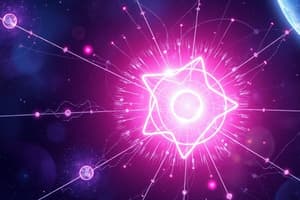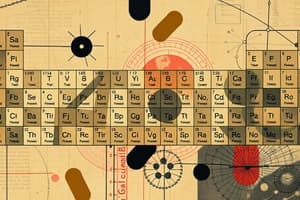Podcast
Questions and Answers
What formula is used to calculate molarity?
What formula is used to calculate molarity?
- M = moles x liters
- M = liters / moles
- M = moles + liters
- M = moles / liters (correct)
Which of the following accurately describes a dilute solution?
Which of the following accurately describes a dilute solution?
- Low concentration of solute (correct)
- Equal concentration of solute and solvent
- No solute present
- High concentration of solute
How does one achieve a dilute solution in the laboratory?
How does one achieve a dilute solution in the laboratory?
- By removing some solvent
- By adding more solvent (correct)
- By increasing the temperature
- By adding more solute
What does Avogadro's number represent?
What does Avogadro's number represent?
If you have 1 mole of NaCl dissolved in 5 liters of water, what is the molarity of the solution?
If you have 1 mole of NaCl dissolved in 5 liters of water, what is the molarity of the solution?
Which of the following best defines concentration?
Which of the following best defines concentration?
What happens to the concentration of a solution if more solvent is added without adding solute?
What happens to the concentration of a solution if more solvent is added without adding solute?
What is the unit commonly used to express molarity?
What is the unit commonly used to express molarity?
Flashcards
Electron Configuration
Electron Configuration
Describes the arrangement of electrons in an atom's energy levels and sublevels, following the Aufbau principle, Hund's rule, and the Pauli exclusion principle. It determines the atom's chemical properties and bonding ability. Represented using notation like 1s²2s²2p⁶, indicating energy level (n), sublevel (s, p, d, f), and number of electrons (superscript).
Molarity
Molarity
A measure of concentration, defined as the number of moles of solute per liter of solution. Crucial for quantifying substance amounts in solutions. Calculated as moles of solute divided by liters of solution: M = moles/ liters. Units are typically mol/L.
Mole
Mole
A unit representing a specific number of particles, typically atoms, molecules, or ions. Avogadro's number (6.022 x 10^23) defines the number of particles in one mole. Fundamental for stoichiometric calculations and understanding chemical reactions.
Concentration
Concentration
Signup and view all the flashcards
Dilute
Dilute
Signup and view all the flashcards
Calculating Molarity
Calculating Molarity
Signup and view all the flashcards
Study Notes
Electron Configuration
- Electron configuration describes the arrangement of electrons in an atom's energy levels and sublevels.
- It follows the Aufbau principle, Hund's rule, and the Pauli exclusion principle.
- It determines the atom's chemical properties and its ability to form bonds.
- Represented using a notation like 1s²2s²2p⁶, indicating the energy level (n), sublevel (s, p, d, f), and number of electrons (superscript).
Molarity
- Molarity (M) is a measure of concentration, defined as the number of moles of solute per liter of solution.
- It's a crucial concept in chemistry for quantifying the amount of a substance in a solution.
- Mathematically, molarity is calculated as moles of solute divided by liters of solution: M = moles/liters.
- Units are typically mol/L.
Moles
- A mole is a unit of measurement representing a specific number of particles, typically atoms, molecules, or ions.
- Avogadro's number (approximately 6.022 x 1023) defines the number of particles in one mole.
- Moles are fundamental for stoichiometric calculations and understanding chemical reactions.
Concentration
- Concentration describes the amount of solute present in a given amount of solvent or solution.
- Molarity is one way to express concentration. Other units include mass percent, ppm, and ppb.
- Understanding concentration is vital for predicting reaction rates and equilibrium shifts.
- High concentration typically means a large amount of solute relative to solvent.
Dilute
- A dilute solution has a low concentration of solute compared to solvent.
- Opposite of concentrated.
- Diluting a solution involves adding more solvent to decrease the concentration of solute.
- Important in lab settings to achieve desired concentrations for experiments.
Calculating Molarity of Moles in Something of a Solution
- To calculate molarity, you need the number of moles of solute and the volume of the solution in liters.
- Example: If you have 0.5 moles of NaCl dissolved in 2.5 liters of water, the molarity of the NaCl solution is: M = 0.5 moles / 2.5 liters = 0.2 M.
- Crucially, volume must be in liters, not milliliters, for molarity calculations.
- Always ensure that your units and the required conversions are handled correctly.
Studying That Suits You
Use AI to generate personalized quizzes and flashcards to suit your learning preferences.




